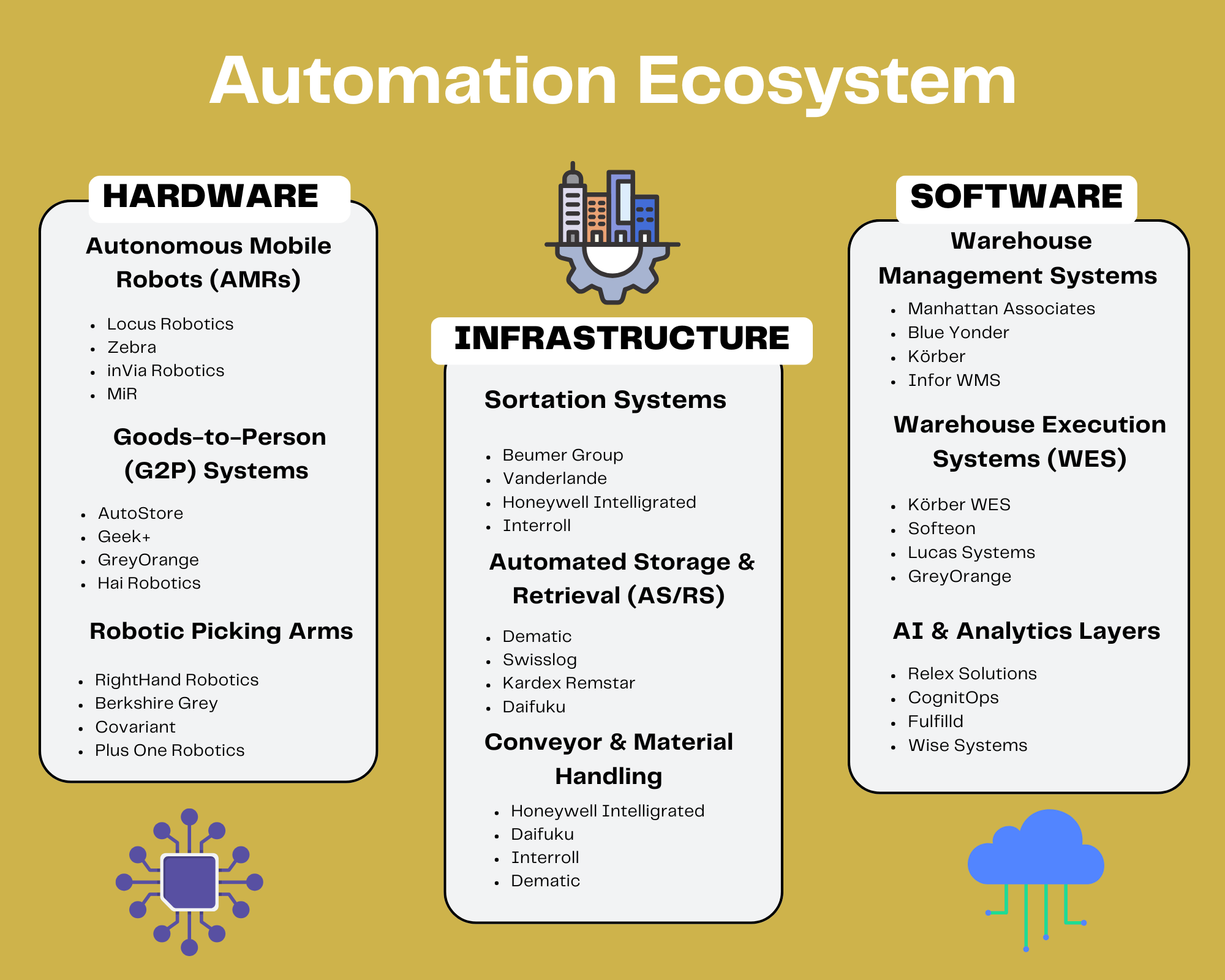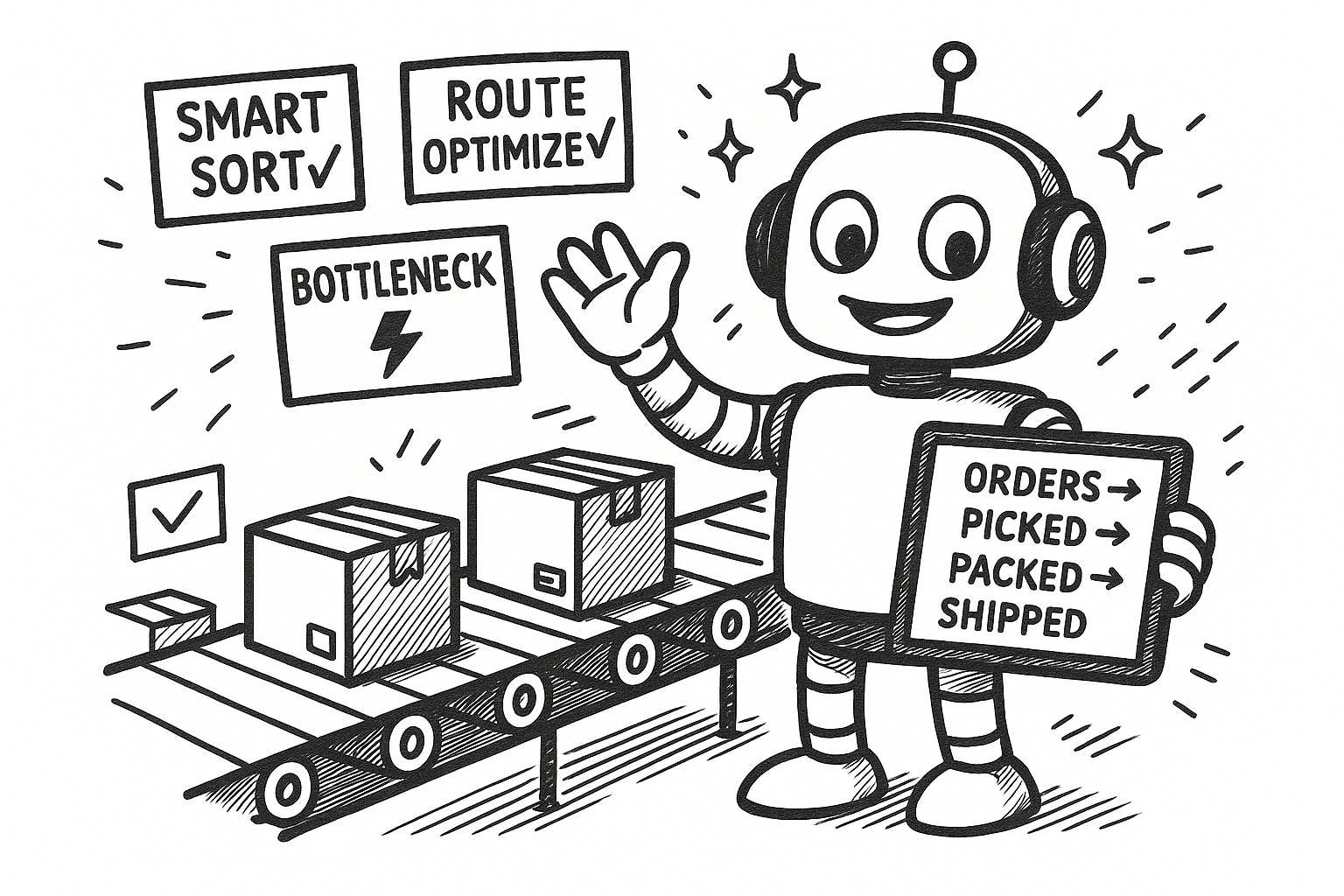TL;DR
Warehouse automation isn’t one big purchase. It’s something you build in stages. Start with a cloud-based warehouse system (WMS) and disciplined processes, then tackle your biggest bottlenecks one layer at a time: use AI vision to cut errors, mobile robots (AMR) to save walking time, goods-to-person systems (G2P) to speed up picking, and sortation when multi-carrier volumes demand it. Keep your setup flexible by connecting tools through orchestration software instead of locking into one vendor. Balance what matters- cost vs flexibility, speed vs control, cloud vs on-site systems and always pilot in one zone before scaling. Match your approach to your business type: start software-first for D2C, orchestrate then automate for mid-market, and retrofit outbound operations while building greenfield sites for enterprise. Automate where it breaks first, not where the demo looks good.
In this guide, we break down automation layers, trade-offs, decision frameworks, and archetype-based roadmaps—so you can plan your next move without over-spending.
Warehouse Automation Tools—Robotics, AI, and More
A few years ago, "automation" meant conveyors and barcode scanners. Today, it means robots picking orders, AI optimizing slotting, and orchestration software dispatching work across humans and machines. The spotlight shifted from "more bodies on the floor" to "better flow through the floor."
Yet many retailers still operate as if nothing has changed—adding headcount instead of optimizing flow. At the same time, Labor is getting tighter, SKUs keep multiplying, and delivery promises keep shrinking. Fulfillment has become a profit choke point, and if you’re still scaling throughput linearly with headcount, margin will give before demand does.
But here is the good news: warehouse automation is no longer an all-or-nothing gamble. It’s modular. You can automate one lane, one workflow, or one shift, and compound wins from there. Think orchestration first, hardware second.

The Modern Warehouse Automation Stack
You don’t buy automation, you assemble a stack.
Start with the jobs that break flow, then pick the layer—physical, infrastructure, or orchestration—that clears the bottleneck fastest. Here are the 3 building blocks:
- Physical Automation (Picking & Transport)
- Goods-to-Person (G2P) Systems
- What It Does: Brings bins/totes to stationary pickers, eliminating most walking time.
- Where it fits: High-SKU e-commerce categories (apparel, electronics, beauty) where accuracy and steady volumes pay back quickly.
- Vendors: AutoStore, Geek+, GreyOrange, Hai Robotics.
- Autonomous Mobile Robots (AMRs)
- What It Does: These self-driving robots navigate warehouse floors using sensors and onboard maps to move totes or pallets between zones.
- Best Fit: Warehouses with dynamic layouts or frequent product mix changes that need flexible automation without large infrastructure investment.
- Vendors: Locus Robotics, Fetch Robotics (Zebra), inVia Robotics, MiR
- Robotic Picking Arms
- What It Does: AI-driven robotic arms identify, grasp, and pack items of varying sizes and shapes using computer vision.
- Best Fit: High-volume grocery, pharma, or retail operations where precision and speed in picking materially change cost per order.
- Vendors: RightHand Robotics, Berkshire Grey, Covariant, Plus One Robotics
- AI-Powered Vision & Sensing
- What It Does: Uses cameras and machine learning to identify, verify, and inspect items—often supporting or enhancing robotic picking and sortation systems.
- Best Fit: Facilities handling diverse or fragile SKUs where visual verification and quality control are critical to reduce manual inspection.
- Vendors: Covariant, Plus One Robotics, OSARO.
- Infrastructure & Facilities
- Sortation Systems
- What It Does: High-throughput conveyors and diverters automatically route parcels to the right lane or carrier.
- Best Fit: Large distribution centers shipping 10K+ orders per day across multiple carriers where end-of-line speed is the bottleneck.
- Vendors: Beumer Group, Vanderlande, Honeywell Intelligrated, Interroll.
- Automated Storage & Retrieval Systems (AS/RS)
- What It Does: High-density, automated storage with cranes/shuttles that retrieve totes, cases, or pallets on command.
- Best Fit: Sites with limited footprint and high SKU counts that need predictable throughput and long-horizon efficiency.
- Vendors: Dematic, Swisslog, Kardex Remstar, Daifuku.
- Micro-Fulfillment Centers (MFCs)
- Software & Orchestration
- Automation-Ready WMS (Orchestration + AI Optimization)
- What It Does: Modern warehouse-management software with native automation control and AI for pick paths, slotting, labor planning, and forecasting.
- Best Fit: Teams shifting from legacy or on-prem WMS to cloud control, running hybrid human-robot operations, and seeking measurable efficiency before heavy CapEx.
- Vendors: Manhattan Active WM / Manhattan SCALE, Blue Yonder Luminate, Infor WMS, Körber, Logiwa, Tecsys.
- Automation Middleware / Control Layer
- What It Does: Vendor-neutral integration and execution layer connects multi-vendor robots, sensors, conveyors, and WMS, standardizing workflows and data across sites.
- Best Fit: Multi-system environments wanting centralized orchestration without replacing their core WMS.
- Vendors: SVT Robotics (SOFTBOT), AWS IoT RoboRunner, LogistiVIEW, Softeon WES.
Modern automation stacks aren’t built all at once. They evolve—one layer, one constraint, one measurable win at a time.

The Trade-Offs: What You’ll Have to Balance
Every warehouse automation decision is a balance between speed, flexibility, and capital control. No two paths are identical, but most fall into a few predictable tensions.
1. Hardware vs Software
Physical automation (robots, conveyors, G2P) boosts throughput fast—but with high upfront cost and long payback. Software-led automation (AI-driven WMS, orchestration tools) delivers quicker ROI and easier pilots but still depends on manual discipline.
👉 Fix workflows first. Hardware amplifies good processes, it doesn’t replace them.
2. Modular vs Integrated
A modular stack lets you start small—automate picking, then packing, then sortation—reducing CapEx and risk. Integrated vendor suites (e.g., Geek+, AutoStore) simplify rollout but increase dependency and switching cost.
👉 Decide early: do you want to own your automation roadmap or outsource complexity?
3. Ownership vs RaaS (Robotics-as-a-Service)
Buying robots outright means higher CapEx upfront but tighter long-term cost control.
RaaS turns automation into an operating expense—flexible, subscription-based, easier to justify to finance—but often costs more over 3–5 years.
👉 Watch for contracts that penalize scaling down during slow seasons.
4. Speed vs Flexibility
Fixed automation (conveyors, AS/RS) delivers unmatched throughput but is rigid.
Mobile automation (AMRs, cobots, picking arms) adapts faster but runs slower per pick.
👉 If your SKU mix or order patterns shift seasonally, flexibility beats raw speed.
5. Cloud vs On-Prem Control
Cloud orchestration gives real-time visibility, open APIs, and faster updates—ideal for multi-site ops.On-prem PLC systems offer control but trap data in silos and slow innovation.
👉 Modern fulfillment runs on open APIs, not isolated control rooms.
You don’t need to automate everything on day one. Start where labor and error costs hurt most, choose scalable layers, and design your automation journey around control and adaptability, not just capacity.
Decision Tools: How to Choose the Right Automation Stack
Once you understand the trade-offs, the next step is evaluating what fits your operations. Use this scorecard and checklist to separate what’s impressive in demos from what actually works on your floor.
1) Evaluation Scorecard (rate 1–5)
- Integration Effort: Native connectors between WMS, robots, ERP → rollout time & reliability
- Throughput & Flexibility: Handles SKU variety and order peaks → scalability during promos/seasonality
- Deployment Model: SaaS, on-prem, or hybrid → cost, control, IT dependence
- AI & Analytics Readiness: Real-time data capture, usable dashboards → proactive optimization
- Scalability: Add capacity (robots, zones, sites) without re-engineering → avoid 18-month ceilings
- Total Cost of Ownership (3–5 yrs): Licenses, maintenance, RaaS fees, training → real ROI timeline
- Maintenance & Support: Uptime SLAs, response times → downtime freezes orders
- Exit / Portability Risk: Ease of migrating bots/data → protect against lock-in
💡 Tip: A stack scoring 4+ on integration, scalability, and support usually pays back faster than one that only scores high on hardware performance.
2. Buyer Checklist: 7 Questions to Ask Vendors
- How does your system integrate with our existing WMS or OMS?
- Can workflows be modified without vendor intervention (e.g., rule editor or low-code tools)?
- What’s the average deployment time and SKU range you support?
- How do you handle exceptions: damaged goods, missed picks, partial shipments?
- Is pricing based on robots, orders, or locations?
- How do you manage predictive maintenance and error recovery?
- What happens if we switch vendors or expand to new sites?
🚩 Red Flag: If your vendor can’t show a live dashboard of order flow across both humans and robots, walk away.
Implementation Reality Check
What vendors won't tell you (but you need to know):
- Timelines always slip. Vendor says 3 months → plan for 5-6 months (facility prep, integration delays, staff training).
- Your WMS might not be ready. Automation depends on clean, real-time inventory data. If your system is messy, robots will just amplify the chaos.
- Cultural resistance is real. Teams often fear that robots mean job loss. Invest early in communication, retraining, and role redesign.
- Maintenance isn't optional. Budget 10-15% of system cost annually for support, parts, and software updates.
- Pilots reveal hidden issues. Always pilot one zone/workflow before full rollout. You might discover edge cases that no demo showed you.
Pick tools that integrate easily, scale predictably, and keep you in control of your data.
The right system adapts as your business evolves — not the other way around.
Right-Sized Automation: What to Deploy, When, and Why
On a high level, your automation journey should always start with a cloud-based WMS and disciplined processes. From there, layer automation based on your biggest operational bottlenecks. Pick the smallest move that fixes your biggest constraint today, then phase in what’s next as volume, budget, and complexity grow.
Frankly, there’s no universal automation stack. The right path depends on your operating model, order volume, and facility footprint. Let's look at a few scenarios.
1. Digital-First Retailer (D2C & Quick Commerce)
For digital-first brands, speed and flexibility matter more than heavy infrastructure. You’re scaling fast but can’t afford over-engineering early. Looking at the growth stages →
Early stage (<500 orders/day): Start with process, not hardware. Implement a cloud-native WMS with intelligent pick-paths, standardize bin locations, and codify training. Automation here would add rigidity when you need flexibility across SKUs, packaging, and returns.
Growth stage (500–3K orders/day): Focus on software-led efficiency. Deploy AI slotting and route optimization in your WMS, add vision-guided pick-to-light or voice wearables, and automate labeling/manifesting. If one workflow breaks (often returns), pilot 2–3 AMRs there only. Avoid floor-wide rollouts.
Scale stage (3K+ orders/day): Walk time becomes the real constraint. Use RaaS AMRs (4–8 units) to flex seasonally, add automated pack stations for right-sized cartonization, and deploy middleware if managing multiple systems. Skip full G2P (too rigid for D2C volatility) and defer sortation until you're consistently operating at enterprise volume with multiple carriers.
Recommended Path: Start software-first (cloud WMS + barcode discipline). Add AI-assisted QC at pack-out + pilot 2–3 AMRs (RaaS) only if walk-time becomes the bottleneck.
However, in case Quick Commerce is a key driver for your business, then just keep in mind that it runs on predictability, not glamour.
In dark stores targeting 10–30 minute SLAs, deploy vertical micro-storage (compact lifts, not full AS/RS), IoT auto-replenishment alerts, and batch-picking with pre-staged totes. Speed comes from inventory positioning and staging discipline, not last-meter robotic picking. Lightweight automation (pick-to-light, voice, AI returns triage) + seasonal RaaS often beats permanent fleets. Hence, in case of Quick Commerce, prioritize predictability and proximity. Deploy vertical micro-storage (compact lifts, not full AS/RS), IoT auto-replenishment alerts, and batch-picking with pre-staged totes near demand. Defer full MFC builds until volumes are stable.
Example Vendors:
- Cloud WMS: Anchanto, Unicommerce, Vinculum, EasyEcom
- AMR (RaaS) — pilot only: Locus Robotics, Fetch Robotics (Zebra), inVia Robotics, MiR.
- QC / Vision add-ons: Covariant, Plus One Robotics, OSARO.
- Micro-storage / G2P/ Shuttle: Addverb, HAI Robotics, Geek+, GreyOrange
- MFC (when justified): AutoStore, Ocado
Why It Matters: Delivers accuracy and throughput gains with minimal CapEx. You prove ROI with process + software first, then rent robots where the math clears.
2. Omnichannel Mid-Market Retailer (10–100 stores)
If you're running stores and e-commerce from the same distribution center, accuracy beats speed. A store mis-ship means 50 wrong units, not one. Most mid-market teams jump to G2P when the real unlock is clean data and orchestration, so robots don’t execute bad instructions faster.
Recommended Path:
# Foundation: Move to an automation-ready WMS. Enable AI slotting, cartonization, and RFID/vision cycle counts to push inventory accuracy to ≥97%.
# Targeted automation: Pilot modular G2P only in the e-com fast-mover zone. Use AMRs for inter-zone tote shuttles. Layer WES/middleware to orchestrate human + robot work and enforce store vs. e-com SLAs.
# Network scale: Add sortation when you're multi-node or multi-carrier (10K+ orders/day) to auto-route store vs. e-com vs. B2B. Consider robotic picking only in the highest-volume accuracy lanes.
# Defer/Skip: Full-facility G2P, AS/RS "big bang" deployments, and MFCs until delivery windows and volume justify the investment.
Example Vendors:
- WMS (automation-ready): Manhattan Active WM / Manhattan SCALE, Blue Yonder Luminate, Infor WMS, Körber, Logiwa, Tecsys.
- WES / Middleware: Körber WES, SVT Robotics (SOFTBOT), AWS IoT RoboRunner, LogistiVIEW, Softeon WES.
- G2P (e-com zone): AutoStore, Geek+, GreyOrange, Hai Robotics.
- AMRs (inter-zone shuttles): Locus Robotics, Fetch Robotics (Zebra), inVia Robotics, MiR.
- Vision / Robotic picking (accuracy lanes): Covariant, Plus One Robotics, OSARO, RightHand Robotics, Berkshire Grey, Covariant, Plus One Robotics
- Sortation (when ready): Beumer Group, Vanderlande, Honeywell Intelligrated, Interroll.
Why It Matters: You fix the real mid-market constraints—inventory accuracy, allocation conflicts, and mixed returns—before adding hardware. That sequencing delivers measurable gains (unit per hour, ship-cutoff reliability, freight savings via right-sized cartonization) without locking you into a single vendor. In short: orchestrate first, automate second. Then scale infrastructure when the network, not the aisle, becomes your bottleneck.
3. Enterprise Retailer (100+ stores, multi-region)
Capital isn't your constraint, agility is. Most enterprise networks operate from 10–20-year-old facilities with legacy WMS/ERP that take quarters to upgrade and union agreements that make automation a negotiation, not a purchase order. The real decision isn't "automate or not,” it's retrofit vs. greenfield, and where to automate first so you don’t stall the network.
Recommended Path:
# Legacy DC (retrofit): Add modular sortation to stabilize cutoffs, deploy AMRs for horizontal transport, and automate pack-out (void fill, taping, labeling, cartonization). Skip AS/RS retrofits and full-site G2P due to structural limitations.
# Greenfield DC (20-year horizon): Design in AS/RS for density, G2P for e-commerce fulfillment, full sortation with auto-induct, and robotic picking only in high-volume accuracy lanes. Keep returns processing flexible.
# Urban micro-fulfillment (10–30 nodes): Deploy compact G2P with micro-sortation near demand, tightly integrated with store OMS/WMS. Skip long conveyors and AGVs in constrained footprints.
# Critical first step: Stand up vendor-neutral WES/middleware. Pilot in one facility, then template the rollout across the network.
Example Vendors:
- WES/Middleware: SVT Robotics (SOFTBOT), LogistiVIEW, Softeon WES.
- Sortation: Beumer Group, Vanderlande, Honeywell Intelligrated, Interroll.
- AMRs: Locus Robotics, Fetch Robotics (Zebra), inVia Robotics, MiR.
- G2P: AutoStore, Geek+, GreyOrange, Hai Robotics.
- AS/RS: Dematic, Swisslog, Kardex Remstar, Daifuku.
- Vision/Picking: Covariant, Plus One Robotics, OSARO, RightHand Robotics
Why it matters: Enterprise constraints are integration and change management, not hardware. Orchestrate first → retrofit outbound operations → add greenfield capacity. Build modular, scale in phases.
Warehouse automation isn’t a one-size revolution. It’s a staged evolution: from visibility, to coordination, to autonomy. The endgame is to remove the repetitive, error-prone, physically demanding work so your team can focus on exceptions, quality, and continuous improvement.
Start where the friction is highest, prove ROI fast, and scale through orchestration, not just machinery.
The right system is the one that:
- Solves your biggest operational bottleneck (labor, accuracy, or space)
- Integrates with your existing WMS without a 12-month IT project
- Scales as your order volume grows—without forcing you to rip and replace
Make decisions from the floor, not based on what you see in the demo room.
Next Steps
- Audit your current warehouse operations: Measure baseline metrics (orders/hour, error rates, cost per order)
- Shortlist 3-4 vendors that align with your volume, budget, and facility constraints
- Demand pilot programs: Test in one zone before committing facility-wide.
- Model TCO across 3-5 years: Include integration, training, maintenance, and potential facility moves
- Talk to 2-3 reference customers in your size/category. Ask about hidden costs and post-implementation surprises
Your warehouse is your fulfillment engine. Automate the right parts, and it becomes your competitive advantage.


.avif)


.avif)